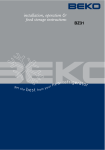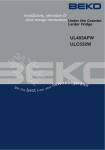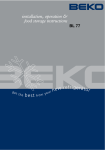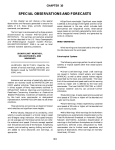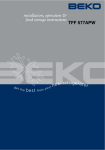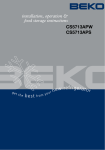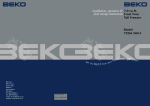Download Beko QL22 Instruction manual
Transcript
Integrated Larder Fridge QL22 Please read this manual first! Dear Customer, We hope that your product, which has been produced in a 1st-class manufacturing facility and checked under the most meticulous quality control procedures, will provide you with years of good service. For this, we recommend you to carefully read the entire manual of your product before using it and keep it at hand for future reference. This manual • Will help you use your appliance quickly and safely. • Read the manual before installing and operating your product. • Follow the instructions, especially those for safety. • Keep the manual in an easily accessible place as you may need it later. • Besides, read also the other documents provided with your product. Please note that this manual may be valid for other models as well. Symbols and their descriptions This instruction manual contains the following symbols: C Important information or useful usage tips. AWarning against dangerous conditions for life and property. BWarning against electric voltage. 2 EN 1 Your Refrigerator 4 4 Preparation 11 2 Warnings 5 5 Using your refrigerator 12 Electrical requirements........................6 Warning! This appliance must be earthed...............................................6 Energy saving tips..............................7 Compliance with WEEE Directive and Disposing of the Waste Product: .......7 Compliance with rohs directive:.........7 Package information...........................7 3 Installation 8 Points to be considered when retransporting your refrigerator..............8 Before operating your refrigerator.......8 Disposing of the packaging................9 Disposing of your old refrigerator........9 Placing and Installation.......................9 Placing the refrigerator under the counter and adjusting the legs..........10 3 Temperature setting button...............12 Defrost.............................................12 Replacing the interior light bulb . ......13 Reversing the doors.........................20 6 Maintenance and cleaning 21 7 Troubleshooting 22 8 Guarantee Details 26 9 How To Obtain Service 27 EN 1 Your Refrigerator 6 7 1 2 1 9 1 3 4 8 5 1. Body shelves 2. Bulb thermostat box 3. Sliding crisper cover 4. Food storage cabin 5. Adjustable front legs 6. Egg compartment 7. Door shelf 8. Bottle shelf 9. Storage container 10. Bottle holder C The figures in this manual are schematic, and they may not be in exact accordance with your product. If the product you purchased does not have the related parts, then they are valid are for other models. 4 EN 2 Warnings • Do not connect your appliance to the electricity supply until all packing and transit protectors have been removed. • If transported horizontally leave to stand upright for at least 4 hours before switching on to allow compressor oil to settle • If you are discarding an old refrigerator with a lock or latch fitted to the door, disable the lock/latch, ensure that it is left in a safe condition to prevent the entrapment of young children. • This fridge/freezer must only be used for its intended purpose i.e the storing and freezing of edible foodstuff. • Do not dispose of the appliance on a fire. At BEKO, the care and protection of our environment is an ongoing commitment. This appliance which is among the latest range introduced is particularly environment friendly. Your appliance contains non CFC / HFC natural substances in the cooling system (Called R600a) and in the insulation (Called cyclopentane) which are potentially flammable if exposed to fire. Therefore, take care not to damage, the cooling circuit / pipes of the appliance in transportation and in use. In case of damage do not expose the appliance to fire or potential ignition source and immediately ventilate the room where the appliance is situated. • We suggest you contact your local authority for disposal information and facilities available. 5 • See Installation Instructions on on page 8 for information on suitable location. • To obtain the best possible performance and trouble free operation from your appliance it is very important to carefully read these instructions. • On delivery, check to make sure that the product is not damaged and that all the parts and accessories are in perfect condition. • Ensure that the plug remains readily accessible. Do not use multiple adapter or extension cable. • Failure to observe these instructions may invalidate your right to free service during the guarantee period. • Keep ventilation openings, in the appliance enclosure or in the built-in structure, clear of obstruction. • Do not use mechanical devices or other means to accelerate the defrosting process, other than those recommended by the manufacturer. • Do not damage the refrigerant circuit. • Do not use electrical appliances inside the food storage compartments of the appliance, unless they are of the type recommended by the manufacturer. • We suggest you keep these instructions in a safe place for easy reference. EN • This appliance can be used by children aged from 8 years and above and persons with reduced physical, sensory or mental capabilities or lack of experience and knowledge if they have been given supervision or instruction concerning use of the appliance in a safe way and understand the hazards involved. Children shall not play with the appliance. Cleaning and user maintenance shall not be made by children without supervision.’ Electrical requirements Before you insert the plug into the wall socket make sure that the voltage and the frequency shown on the rating plate inside the appliance corresponds to yourelectricity supply. Rating label is on the left hand side of fridge inner liner. We recommend that this appliance be connected to the mains supply via a Suitable switched and fused socket. The appliance must be positioned so that the plug is accessible. Should the mains lead of the appliance become damaged or should it need Replacing at any time, it must be replaced by a special purpose made mains lead which can only be obtained from a BEKO authorised service agent. Warning! This appliance must be earthed The moulded plug on this appliance incorporates a 13 A fuse. Should the fuse need to be replaced an ASTABEAB approved BS 1362 fuse of the same rating must be used. Do not forget to refit the fuse cover. In the event of losing the fuse cover the plug must not be used until a replacement fuse cover has been fitted. Colour of the replacement fuse cover must be the same colour as that visible on the pin face of the plug. Fuse covers are available from any good electrical store. Important! Fitting A Different Plug As the colours of the wires in the mains lead of this appliance may not correspond with the coloured markings identifying the terminals in your plug proceed as follows: (See diagram). 1. Connect the green-yellow or green (Earth) wire to the terminal in the plug marked ‘E’ or with the symbol or coloured green and yellow or green. 2. Connect the blue (Neutral) wire to the terminal in the plug marked ‘N’ or coloured black. 3. Connect the brown (Live) wire to the terminal in the plug marked ‘L’ or coloured red. With alternative plugs a 13 A fuse must be fitted either in the plug or adaptor or in the main fuse box. If in doubt contact a qualified electrician. If the fitted moulded plug is not suitable for your socket, then the plug should be cut off and an appropriate plug fitted. Destroy the old plug which is cut off as a plug with bared cord could cause a shock hazard if inserted into a socket elsewhere in the house. 6 EN Energy saving tips 1. Ensure your appliance is installed in a well ventilated area. 2. Ensure the time between buying chilled/frozen food and placing them in your appliance is kept at minimum, particularly in summer. We recommend you use a cool bag or a special carrier bag to carry perishable food. 3. Do not leave the door (s) of your appliance open longer than necessary and ensure they are closed properly after each opening. 4. Defrost frozen food in the fridge compartment, so that frozen food acts as an ice pack to assist cooling in the fridge. 5. Energy consumption of this appliance is measured while freezer compartment is loaded without use of top shelf lid and the drawers except the bottom drawer. It is advised that freezer compartment is loaded without use of drawers except the bottom drawer in order to achieve maximum loading capacity. and other wastes at the end of its service life. Take it to the collection center for the recycling of electrical and electronic equipment. Please consult your local authorities to learn about these collection centers. Compliance with rohs directive: The product you have purchased complies with EU RoHS Directive (2011/65/EU). It does not contain harmful and prohibited materials specified in the Directive. Package information Packaging materials of the product are manufactured from recyclable materials in accordance with our National Environment Regulations. Do not dispose of the packaging materials together with the domestic or other wastes. Take them to the packaging material collection points designated by the local authorities. Compliance with WEEE Directive and Disposing of the Waste Product: This product complies with EU WEEE Directive (2012/19/EU). This product bears a classification symbol for waste electrical and electronic equipment (WEEE).This product has been manufactured with high quality parts and materials which can be reused and are suitable for recycling. Do not dispose of the waste product with normal domestic 7 EN 3 Installation BPlease remember that the manufacturer shall not be held liable if the information given in the instruction manual is not observed. Points to be considered when re-transporting your refrigerator 1. Your refrigerator must be emptied and cleaned prior to any transportation. 2. Shelves, accessories, crisper and etc. in your refrigerator must be fastened securely by adhesive tape against any jolt before repackaging. 3. Packaging must be adequate to protect the product and the rules of transportation printed on the package must be followed. Please do not forget… Every recycled material is an indispensable source for the nature and for our national resources. If you wish to contribute to recycling the packaging materials, you can get further information from the environmental bodies or local authorities. Before operating your refrigerator Before starting to use your refrigerator check the following: 1. Is the interior of the refrigerator dry and can the air circulate freely in the rear of it? 2. Clean the interior of the refrigerator as recommended in the “Maintenance and cleaning” section. 8 3. Plug the refrigerator into the wall outlet. When the fridge door is open the fridge compartment interior light will come on. 4. You will hear a noise as the compressor starts up. The liquid and gases sealed within the refrigeration system may also give rise to noise, even if the compressor is not running and this is quite normal. 5. Front edges of the refrigerator may feel warm. This is normal. These areas are designed to be warm to avoid condensation. Electric connection Connect your product to a grounded socket which is being protected by a fuse with the appropriate capacity. Important: • The connection must be in compliance with national regulations. • The power cable plug must be easily accessible after installation. • The specified voltage must be equal to your mains voltage. • Extension cables and multiway plugs must not be used for connection. BA damaged power cable must be replaced by a qualified electrician. BProduct must not be operated before it is repaired! There is danger of electric shock! EN Disposing of the packaging Placing and Installation The packing materials may be dangerous for children. Keep the packing materials out of the reach of children or dispose them of by classifying them in accordance with the waste instructions. Do not dispose them of along with the normal household waste. The packing of your refrigerator is produced from recyclable materials. 1. Install your refrigerator to a place that allows ease of use. 2. Keep your refrigerator away from heat sources, humid places and direct sunlight. 3. There must be appropriate air ventilation around your refrigerator in order to achieve an efficient operation. If the refrigerator is to be placed in a recess in the wall, there must be at least 5 cm distance with the ceiling and at least 5 cm with the wall. If the floor is covered with a carpet, your product must be elevated 2.5 cm from the floor. 4. Place your refrigerator on an even floor surface to prevent jolts. 5. Do not keep your refrigerator in ambient temperatures under 10°C. Disposing of your old refrigerator Dispose of your old machine without giving any harm to the environment. • You may consult your authorized dealer or waste collection center of your municipality about the disposal of your refrigerator. Before disposing of your refrigerator, cut out the electric plug and, if there are any locks on the door, make them inoperable in order to protect children against any danger. 9 EN Placing the refrigerator under the counter and adjusting the legs When you place your refrigerator, the distance between the product and the wall must be at least 10 cm, as seen in the figure. The air ventilation channels must not be blocked so that the performance of your refrigerator does not decrease. (140 cm2) If your refrigerator is unstable; You may turn the front legs of your refrigerator as seen in the figure to balance it. The corner of the leg lowers when the leg is turned in the direction of the black arrow; it rises when the leg is turned in the opposite direction. It will be easier for you when you get some help from someone to lift the unit a little during this process. 10 mm 10 mm 40 mm 10 EN 40 mm 4 Preparation • Your refrigerator should be installed at least 30 cm away from heat sources such as hobs, ovens, central heater and stoves and at least 5 cm away from electrical ovens and should not be located under direct sunlight. • The ambient temperature of the room where you install your refrigerator should at least be 10°C. Operating your refrigerator under cooler conditions is not recommended with regard to its efficiency. • Please make sure that the interior of your refrigerator is cleaned thoroughly. • If two refrigerators are to be installed side by side, there should be at least 2 cm distance between them. • When you operate your refrigerator for the first time, please observe the following instructions during the initial six hours. • The door should not be opened frequently. • It must be operated empty without any food in it. • Do not unplug your refrigerator. If a power failure occurs out of your control, please see the warnings in the “Recommended solutions for the problems” section. • Original packaging and foam materials should be kept for future transportations or moving. 11 EN 5 Using your refrigerator Temperature setting button Defrost The interior temperature of your refrigerator changes for the following reasons; • Seasonal temperatures, • Frequent opening of the door and leaving the door open for long periods, • Foods put into the refrigerator without decreasing the temperature to room temperature. • The location of the refrigerator in the room (eg. exposing to sunlight) You may adjust the varying interior temperature using the thermostat. If the ambient temperature is higher than 32°C, switch the thermostat button to maximum position. It is normal when ice particles form on the back wall during the operation. These do not need to be scratched or wiped out. Your refrigerator makes automatical defrost. Water formed after defrost flows into the evaporation container via the drain pipe through the water collecting chute, and here it evaporates automatically. 12 • Check periodically whether the evaporation pipe is clogged and unclog it using the stick in the hole if necessary. EN Replacing the interior light bulb Should the light fail to work switch off at the socket outlet and pull out the mains plug. Follow the below instructions to check if the light bulb has worked itself loose. If the light still fails to work obtain a replacement E14 screw cap type 15 Watt (Max) bulb from your local electrical store and then fit it as follows: 1. Switch off at the socket outlet and pull out the mains plug. You may find it useful to remove shelves for easy access. 2. Remove the light diffuser cover as shown in figure (a-b). 3. Replace the burnt-out light bulb. 4. Reassemble the light diffuser cover as shown in figure (c).“Push firmly to ensure cover is fitted properly.” 5. Carefully dispose of the burnt-out light bulb immediately. “Replacement light bulb can easily be obtained from a good local electrical or DIY store.” 13 EN 14 EN 15 EN Note: Installation step for 2, screws for connecting the top plastic part should not be fully tightened until final left-right adjustment. 16 EN 17 EN 18 EN 19 EN Reversing the doors 20 EN 6 Maintenance and cleaning • We recommend that you switch off the appliance at the socket outlet and pull out the mains plug before cleaning. • Never use any sharp abrasive instrument, soap, household cleaner, detergent and wax polish for cleaning. • Use luke warm water to clean the cabinet of the appliance and wipe it dry. • Use a damp cloth wrung out in a solution of one teaspoon of bicarbonate of soda to one pint of water to clean the interior and wipe it dry. • Make sure that no water enters the lamp housing. • If the appliance is not going to be used for a long period of time switch it off, remove all food, clean it and leave the door ajar. • Any dust that gathers on the condenser, which is located at the back of the appliance, should be removed once a year with a vacuum cleaner. • Check door seals regularly to ensure they are clean and free from food particles. • Removal of door rack • To remove door racks, remove all the contents and then simply push the door rack upwards from the base. 21 • To remove a freezer drawer, pull it as far as possible, and then tilt it upwards, and then pull it out completely. • To remove the freezer flap door, first open the door 3” and then gently pull it off. Make sure that the flap is in place before closing the freezer door. • Make sure that the special plastic container (drain tray) at the back of the appliance which collects defrost water is clean at all times. If you want to remove the tray to clean it follow the instructions below : • Switch off at the socket outlet and pull out the mains plug. • Push the lug down with the tip of a screw driver & pull out with a jerk movement • Clean the drain tray and wipe it dry. • Reassemble reversing the sequence and operations. • Avoid spillage of food particularly small items like rice, peas, beans through the fan guard as they may cause the cooling system to block and therefore operate less efficiently. EN 7 Troubleshooting Please review this list before calling the service. It will save your time and money. This list includes frequent complaints that are not arising from defective workmanship or material usage. Some of the features described here may not exist in your product. The refrigerator does not operate. • The plug is not inserted into the socket correctly. >>>Insert the plug into the socket securely. • The fuse of the socket which your refrigerator is connected to or the main fuse have blown out. >>>Check the fuse. Condensation on the side wall of the fridge compartment (MULTIZONE, COOL CONTROL and FLEXI ZONE). • Ambient is very cold. >>>Do not install the refrigerator in places where the temperature falls below 10 °C. • Door has been opened frequently. >>>Do not open and close the door of refrigerator frequently. • Ambient is very humid. >>>Do not install your refrigerator into highly humid places. • Food containing liquid is stored in open containers. >>>Do not store food with liquid content in open containers. • Door of the refrigerator is left ajar. >>>Close the door of the refrigerator. • Thermostat is set to a very cold level. >>>Set the thermostat to a suitable level. • Compressor is not running • Protective thermic of the compressor will blow out during sudden power failures or plug-out plug-ins as the refrigerant pressure in the cooling system of the refrigerator has not been balanced yet. The refrigerator will start running approximately after 6 minutes. Please call the service if the refrigerator does not startup at the end of this period. • The fridge is in defrost cycle. >>>This is normal for a full-automatically defrosting refrigerator. Defrosting cycle occurs periodically. • The refrigerator is not plugged into the socket. >>>Make sure that the plug is fit into the socket. • Temperature settings are not made correctly. >>>Select the suitable temperature value. • There is a power outage. >>>Refrigerator returns to normal operation when the power restores. 22 EN The operation noise increases when the refrigerator is running. • The operating performance of the refrigerator may change due to the changes in the ambient temperature. It is normal and not a fault. The refrigerator is running frequently or for a long time. • New product may be wider than the previous one. Larger refrigerators operate for a longer period of time. • The room temperature may be high. >>>It is normal that the product operates for longer periods in hot ambient. • The refrigerator might be plugged in recently or might be loaded with food. >>>When the refrigerator is plugged in or loaded with food recently, it will take longer for it to attain the set temperature. This is normal. • Large amounts of hot food might be put in the refrigerator recently. >>>Do not put hot food into the refrigerator. • Doors might be opened frequently or left ajar for a long time. >>>The warm air that has entered into the refrigerator causes the refrigerator to run for longer periods. Do not open the doors frequently. • Freezer or fridge compartment door might be left ajar. >>>Check if the doors are closed completely. • The refrigerator is adjusted to a very low temperature. >>>Adjust the refrigerator temperature to a warmer degree and wait until the temperature is achieved. • Door seal of the fridge or freezer may be soiled, worn out, broken or not properly seated. >>>Clean or replace the seal. Damaged/broken seal causes the refrigerator to run for a longer period of time in order to maintain the current temperature. Freezer temperature is very low while the fridge temperature is sufficient. • The freezer temperature is adjusted to a very low value. >>>Adjust the freezer temperature to a warmer degree and check. Fridge temperature is very low while the freezer temperature is sufficient. • The fridge temperature is adjusted to a very low value. >>>Adjust the fridge temperature to a warmer degree and check. Food kept in the fridge compartment drawers is frozen. • The fridge temperature is adjusted to a very high value. >>>Adjust the fridge temperature to a lower value and check. 23 EN Temperature in the fridge or freezer is very high. • The fridge temperature is adjusted to a very high value. >>>Fridge compartment temperature setting has an effect on the temperature of the freezer. Change the temperatures of the fridge or freezer and wait until the relevant compartments attain a sufficient temperature. • Doors are opened frequently or left ajar for a long time. >>>Do not open the doors frequently. • Door is ajar. >>>Close the door completely. • The refrigerator is plugged in or loaded with food recently. >>>This is normal. When the refrigerator is plugged in or loaded with food recently, it will take longer for it to attain the set temperature. • Large amounts of hot food might be put in the refrigerator recently. >>>Do not put hot food into the refrigerator. • Vibrations or noise. • The floor is not level or stable. >>> If the refrigerator rocks when moved slowly, balance it by adjusting its feet. Also make sure that the floor is strong enough to carry the refrigerator, and level. • The items put onto the refrigerator may cause noise. >>>Remove the items on top of the refrigerator. There are noises coming from the refrigerator like liquid flowing, spraying, etc. • Liquid and gas flows occur in accordance with the operating principles of your refrigerator. It is normal and not a fault. Whistle comes from the refrigerator. • Fans are used in order to cool the refrigerator. It is normal and not a fault. Condensation on the inner walls of refrigerator. • Hot and humid weather increases icing and condensation. It is normal and not a fault. • Doors are opened frequently or left ajar for a long time. >>>Do not open the doors frequently. Close them if they are open. • Door is ajar. >>>Close the door completely. 24 EN Humidity occurs on the outside of the refrigerator or between the doors. • There might be humidity in the air; this is quite normal in humid weather. When the humidity is less, condensation will disappear. Bad odour inside the refrigerator. • No regular cleaning is performed. >>>Clean the inside of the refrigerator regularly with a sponge, lukewarm water or carbonate dissolved in water. • Some containers or package materials may cause the smell. >>>Use a different container or different brand packaging material. • Food is put into the refrigerator in uncovered containers. >>>Keep the food in closed containers. Microorganisms spreading out from uncovered containers can cause unpleasant odours. • Remove the foods that have expired best before dates and spoiled from the refrigerator. The door is not closing. • Food packages are preventing the door from closing. >>>Replace the packages that are obstructing the door. • The refrigerator is not completely even on the floor. >>>Adjust the feet to balance the refrigerator. • The floor is not level or strong. >>>Make sure that the floor is level and capable to carry the refrigerator. Crispers are stuck. • The food is touching the ceiling of the drawer. >>>Rearrange food in the drawer. 25 EN 8 Guarantee Details GUARANTEE DETAILS Your new Beko product is guaranteed against the cost of breakdown repair for two years from the date of the original purchase. What is covered? • Repairs necessary as a result of faulty materials, defective components or manufacturing defect. • The cost of functional replacement parts, but excluding consumable items. • The labour costs of a Beko approved repairer to carry out the repair. What is not covered? • Transit, delivery or accidental damage or misuse and abuse. • Cabinet or appearance parts, including control knobs, flaps, handles or container lids. • Accessories or consumable items including but not limited to, ice trays, scrapers, cutlery baskets, filters and light bulbs. • Repairs required as a result of unauthorised repair or inexpert installation that fails to meet the requirements contained in the user instruction book. • Repairs to products used on commercial or non-residential household premises. • Loss of frozen food in freezers or fridge/freezers. (Food loss insurance is often included within your household contents insurance policy, or may be available separately from your retailer). Important notes. • Your Beko product is designed and built for domestic household use only. • The guarantee will be void if the product is installed or used in commercial or non-residential domestic household premises. • The product must be correctly installed, located and operated in accordance with the instructions contained in the User Instructions Booklet provided. • Professional installation by a qualified Electrical Domestic Appliance Installer is recommended for all Washing Machines, Dishwashers and Electric Cookers • Gas Cookers must only be installed by a Gas Safe (or BORD GAIS) registered Gas Installer. • The guarantee is given only within the boundaries of the United Kingdom and the Republic of Ireland. • The guarantee is applicable only to new products and is not transferable if the product is resold. • Beko disclaims any liability for incidental or consequential damages. The guarantee does not in anyway diminish your statutory or legal rights. 26 EN 9 How To Obtain Service HOW TO OBTAIN SERVICE Please keep your purchase receipt or other proof of purchase in a safe place; you will need to have it should the product require attention under guarantee. You should also complete the details below; it will help us assist you when requesting service. (The model number is printed on the Instruction Booklet and the serial number is printed on the Rating Label affixed to the appliance) Model No: Serial No: Retailer: Date of purchase: For service under guarantee simply telephone the appropriate number below UK Mainland & Northern Ireland Fridges & Freezers Electric Cookers Gas & Dual Fuel Cookers Washing Machines & Dishwashers 0845 6004903 0845 6004902 0845 6004905 0845 6004906 Republic of Ireland All Refrigeration, All Cookers Washing Machines & Dishwashers 01 862 3411 Before requesting service please check the trouble-shooting guide in the Operating Instructions as a charge may be levied where no fault is found even though your product may still be under guarantee. Service once the manufacturers guarantee has expired. If you have purchased an extended guarantee please refer to the instructions contained within the extended guarantee agreement document. Otherwise please call the appropriate number above where service can be obtained at a charge. Should you experience any difficulty in obtaining service please contact the Beko Customer Help-Line. Tel: 0845 6004911 e-mail: [email protected] 27 EN BEKO plc Beko House Caxton Way Watford Hertfordshire WD18 8UF Tel: 0845 6004911 Fax: 0845 6004922 e-mail: [email protected] website: www.beko.co.uk Printed in Turkey Part no:57 3648 0000 Revision no: AF





























